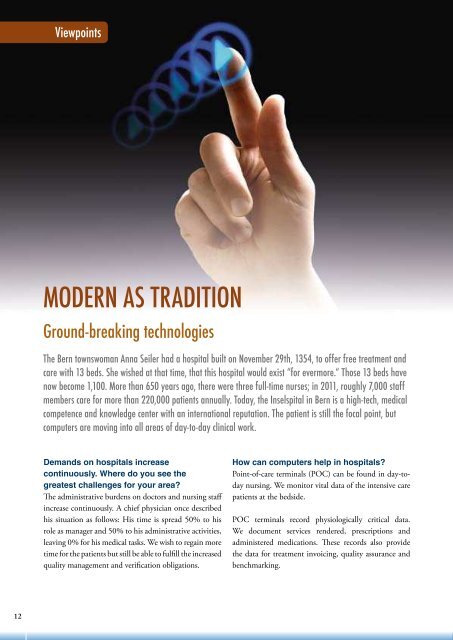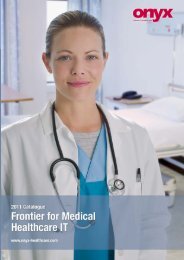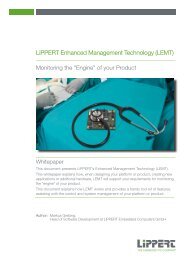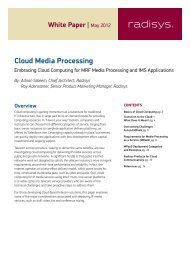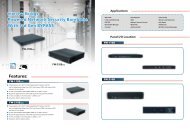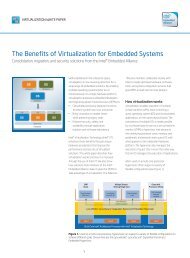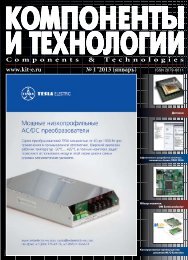Knowledge helps healing - Embedded Community - Intel
Knowledge helps healing - Embedded Community - Intel
Knowledge helps healing - Embedded Community - Intel
You also want an ePaper? Increase the reach of your titles
YUMPU automatically turns print PDFs into web optimized ePapers that Google loves.
viewpoints<br />
ModeRn as TRadiTion<br />
ground-breaking technologies<br />
The bern townswoman anna seiler had a hospital built on november 29th, 1354, to offer free treatment and<br />
care with 13 beds. She wished at that time, that this hospital would exist “for evermore.“ Those 13 beds have<br />
now become 1,100. More than 650 years ago, there were three full-time nurses; in 2011, roughly 7,000 staff<br />
members care for more than 220,000 patients annually. Today, the Inselspital in Bern is a high-tech, medical<br />
competence and knowledge center with an international reputation. The patient is still the focal point, but<br />
computers are moving into all areas of day-to-day clinical work.<br />
Demands on hospitals increase<br />
continuously. Where do you see the<br />
greatest challenges for your area?<br />
The administrative burdens on doctors and nursing staff<br />
increase continuously. A chief physician once described<br />
his situation as follows: His time is spread 50% to his<br />
role as manager and 50% to his administrative activities,<br />
leaving 0% for his medical tasks. We wish to regain more<br />
time for the patients but still be able to fulfill the increased<br />
quality management and verification obligations.<br />
How can computers help in hospitals?<br />
Point-of-care terminals (POC) can be found in day-today<br />
nursing. We monitor vital data of the intensive care<br />
patients at the bedside.<br />
POC terminals record physiologically critical data.<br />
We document services rendered, prescriptions and<br />
administered medications. These records also provide<br />
the data for treatment invoicing, quality assurance and<br />
benchmarking.<br />
Where do you see further application areas<br />
in the intensive care unit?<br />
We have equipped 50 beds with Advantech‘s POC<br />
terminals in a first project. The positive experience<br />
motivates us to also introduce these terminals in the<br />
Anesthesia department. We are currently equipping<br />
our transport beds with Advantech battery operated<br />
POCs. We often travel long distances within our clinic<br />
compound when we transport our patients to other clinic<br />
buildings for special examinations. It takes two or more<br />
hours before the patient is returned to the intensive care<br />
unit. The vital data continues to be monitored with the<br />
mobile POC at the transport beds providing continuous<br />
recording. This ensures greater security for the patients.<br />
What are the trends that you see?<br />
Mobility is increasing. Quality demands are rising.<br />
Changing billing models require more accurate<br />
documentation of the services rendered. Analysis systems<br />
such as benchmarking give transparency, but also need<br />
to be supplied with relevant data. Specialists, specialist<br />
hospitals and finances are limited resources, which do<br />
not keep up with needs. Costs must be reduced, or at<br />
least kept constant.<br />
What do you hope to see<br />
for information technology?<br />
The driving factors for the next hardware generation<br />
will be size, mobility and compatibility. This means,<br />
equipment must be smaller, have a long service life, work<br />
reliably and be connectable to standardized accessories.<br />
The PC must fit in the staff member’s pocket. And it<br />
must, of course, possess a powerful but affordable<br />
rechargeable battery. It would be excellent if accessories<br />
such as bar-code scanners or label printers were already<br />
integrated. Devices should function reliably and have<br />
an appropriately long service life suited for use in a<br />
medical environment. I also would like to see a “medical<br />
cockpitfor” the software, in which access to all data was<br />
intuitive. At present, one must still know which software<br />
package delivers which information.<br />
Where does the future lie in your opinion?<br />
It is conceivable that expert systems will assist with initial<br />
diagnosis. Computer-controlled check-lists will alleviate<br />
stress in the casualty department. Telemedicine will<br />
permit global access to specialists, who will be able to<br />
assist during operations using computerized support<br />
systems. Virtual patients could contribute to safe<br />
treatment, as has been already used successfully in the<br />
pathology area. When in doubt, the computer has the<br />
steadier hand and doesn’t slip with the scalpel. The<br />
processes and procedures in the hospital differ according<br />
to the medical specialization which make a clear case for<br />
a medical cockpit, that is, one software package that can<br />
be configured individually for each clinic.<br />
University clinic for intensive care<br />
medicine at the Inselspital Bern (KIM)<br />
Adult patients at the Inselspital who need intensive<br />
medical care after an accident or surgical operation<br />
are treated here. Specialists work around the clock<br />
to care for patients whose cardiovascular system,<br />
breathing or brain require special attention. An<br />
important milestone was reached in 2010 with the<br />
KommuniKIM project. The project had the goal<br />
to improve and optimize the inter-disciplinary<br />
communication of all patient-relevant information.<br />
1 st 12 1 issue 2011 13<br />
st issue 2011


